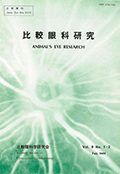Volume 8, Issue 1-2
Displaying 1-13 of 13 articles from this issue
- |<
- <
- 1
- >
- >|
Lecture and Reports at 8th Symposium on Some Problems in the Field of Comparative Ophthalmology
Special Lecture
-
1989 Volume 8 Issue 1-2 Pages 1-12
Published: 1989
Released on J-STAGE: December 25, 2020
Download PDF (4638K)
Reports
-
1989 Volume 8 Issue 1-2 Pages 23-26
Published: 1989
Released on J-STAGE: December 25, 2020
Download PDF (1165K) -
1989 Volume 8 Issue 1-2 Pages 27-32
Published: 1989
Released on J-STAGE: December 25, 2020
Download PDF (2178K) -
1989 Volume 8 Issue 1-2 Pages 33-38
Published: 1989
Released on J-STAGE: December 25, 2020
Download PDF (1846K) -
1989 Volume 8 Issue 1-2 Pages 39-46
Published: 1989
Released on J-STAGE: December 25, 2020
Download PDF (2640K)
Poster Session
-
1989 Volume 8 Issue 1-2 Pages 49-51
Published: 1989
Released on J-STAGE: December 25, 2020
Download PDF (711K) -
1989 Volume 8 Issue 1-2 Pages 53-54
Published: 1989
Released on J-STAGE: December 25, 2020
Download PDF (1063K) -
1989 Volume 8 Issue 1-2 Pages 59-60
Published: 1989
Released on J-STAGE: December 25, 2020
Download PDF (678K) -
1989 Volume 8 Issue 1-2 Pages 63-64
Published: 1989
Released on J-STAGE: December 25, 2020
Download PDF (428K) -
1989 Volume 8 Issue 1-2 Pages 65-67
Published: 1989
Released on J-STAGE: December 25, 2020
Download PDF (794K) -
1989 Volume 8 Issue 1-2 Pages 69-71
Published: 1989
Released on J-STAGE: December 25, 2020
Download PDF (901K) -
1989 Volume 8 Issue 1-2 Pages 73-74
Published: 1989
Released on J-STAGE: December 25, 2020
Download PDF (595K)
Original Report
-
1989 Volume 8 Issue 1-2 Pages 77-80
Published: 1989
Released on J-STAGE: December 25, 2020
Download PDF (1490K)
- |<
- <
- 1
- >
- >|
